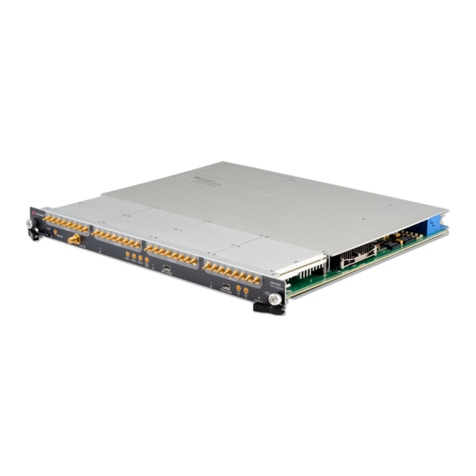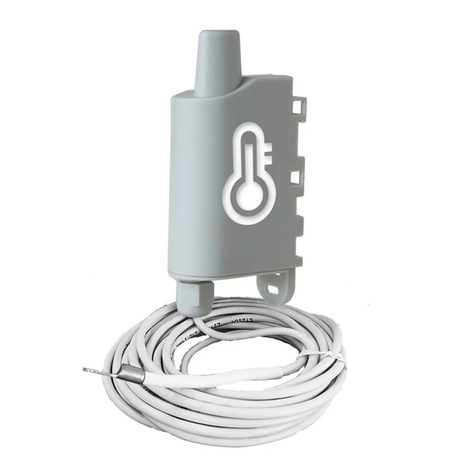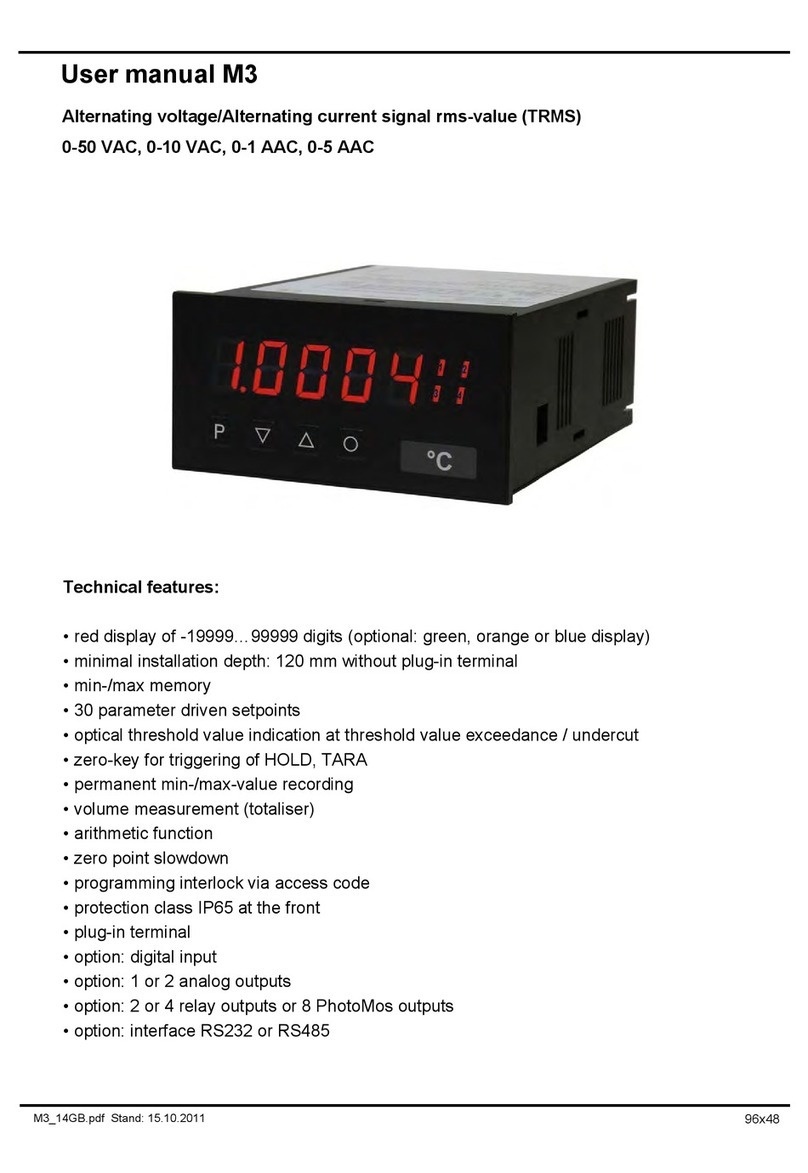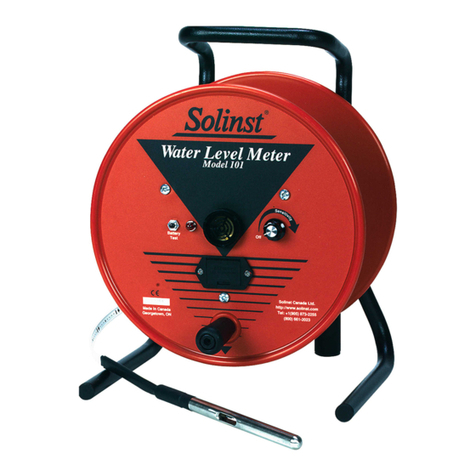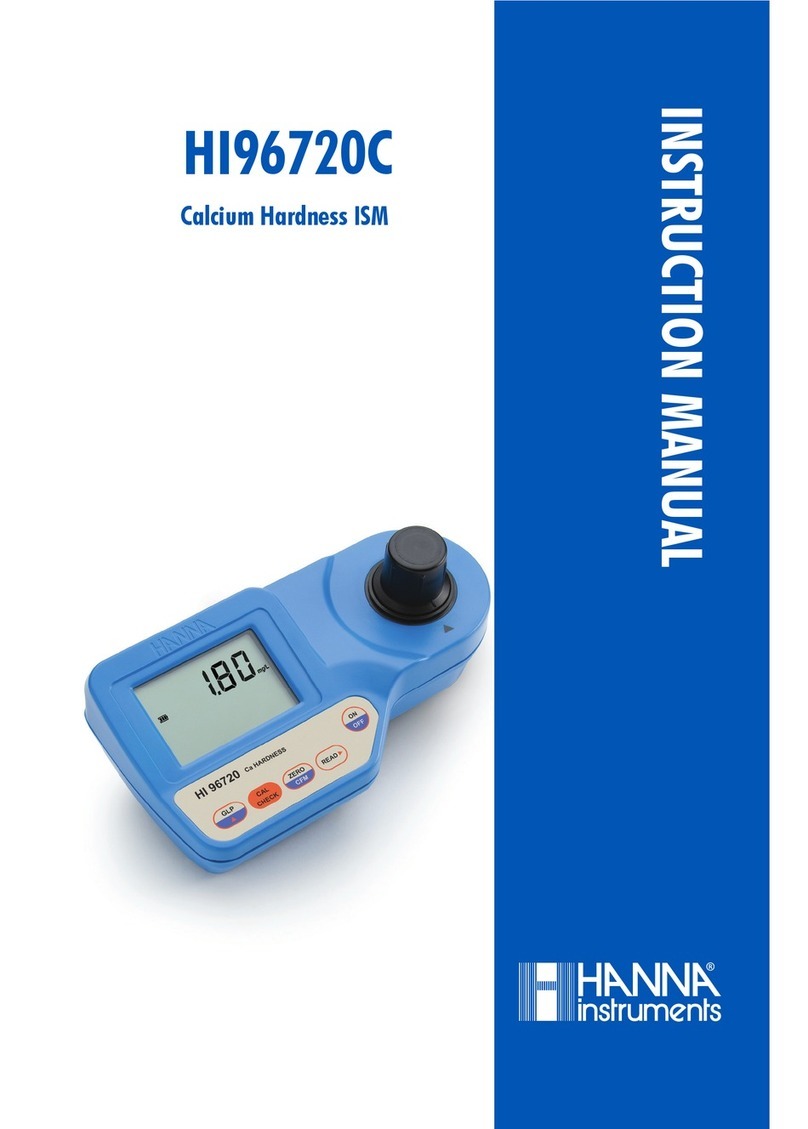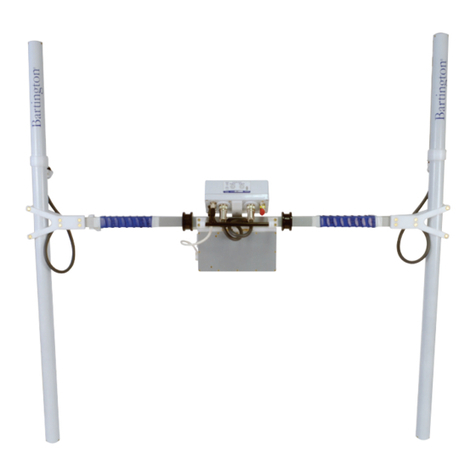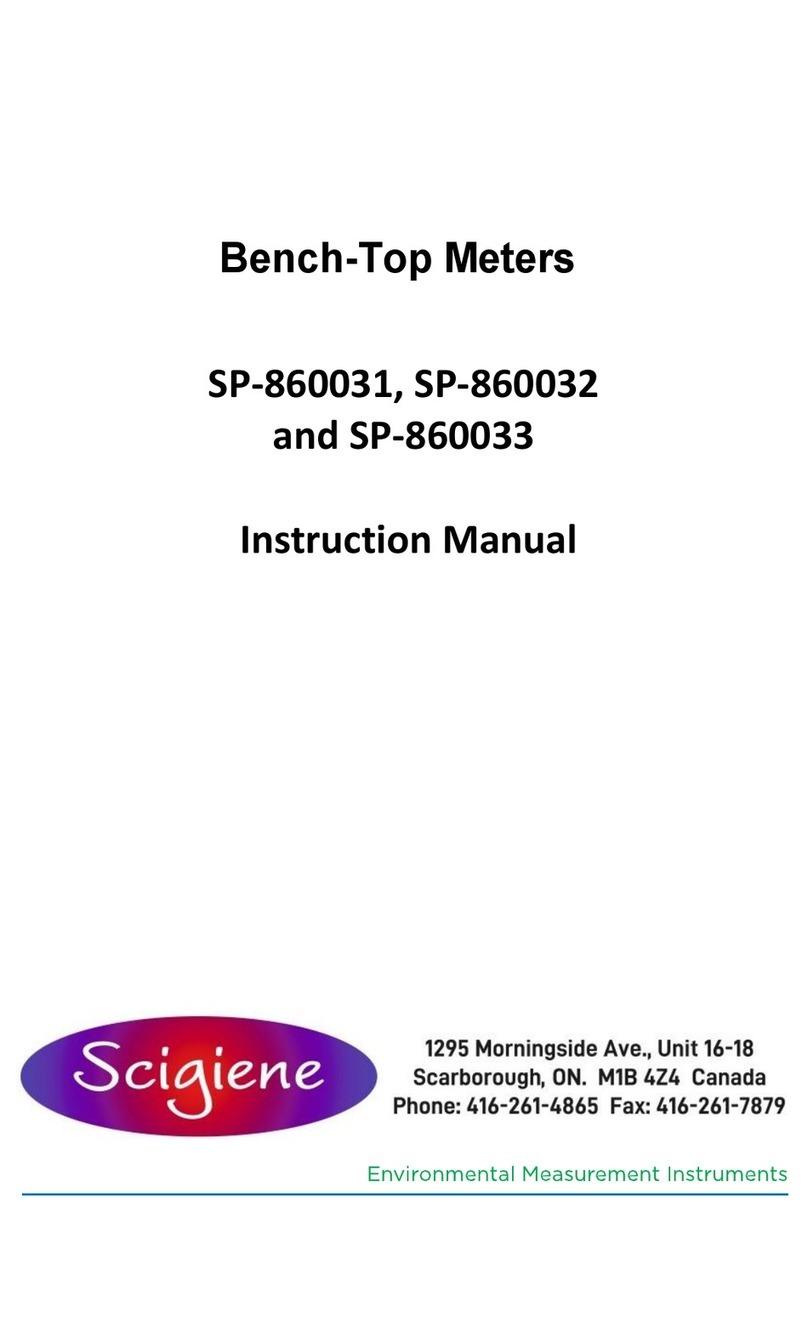TESTO AG 400 User manual

Instruction manual V 2.02
Precision multi-function measuring instrument
testo 950
Precision temperature measuring instrument
testo 650
Precision humidity measuring instrument
testo 400

3
2
Introduction
Dear Customer
You have made the right decision by choosing a measuring instrument from Testo. Thousands of
customers buy our high standard products every year. There are at least 7 good reasons for doing so:
1) Cost - performance ratio. Reliable quality at a fair price.
2) Extended warranty times of up to 3 years - depending on instrument.
3) We have the ideal solutions for your measuring tasks based on our expert experience gained
over 40 years.
4) Our high quality standard is confirmed by the ISO 9001 certificate.
5) Of course, our instruments carry the CE symbol required by the EU.
6) Calibration certificates for all relevant parameters. Seminars, advice and calibration on
location.
7) Our after-sales service. Ask for more details.
Your measuring instrument is a flexible, future-oriented system whose range of operations and
software can vary according to installation.
Once the instrument is switched on, you will receive information on the type of instrument installed,
the serial number as well as information on the current software version in the instrument.
Additional information on our service points, for example, can be printed (See page 16).
(See page 16).
The instruction manual describes the maximum available range of functions in the
testo 400.testo 650 and testo 950 have limited derived functions in relation to the probes
which can be connected and the parameters which can be analysed - See table:
testo 650 and testo 950 can also be subsequently upgraded to include the full range of
functions of testo 400.
We will also continue to make branch-specific and user-specific software updates for these
instruments available to you. All you need to do is register yourself as a user so that we can inform
you directly via NEWS.
Parameter testo 400 testo 650 testo 950
Temperature °C x x x
Humidity %RH x x -
Pressure hPa ... bar x x -
Velocity m/s, m3/h x - -
Gas CO x x x
Gas CO2xxx
rpm x x x
Voltage V x x x
Current I x x x
WBGT °C x - -
NET °C x - -
i
Update on disk
Contents
Introduction.................................................................................................................................3
Initial operation of instrument ..................................................................................................4
Description of instrument..........................................................................................................6
Function fields ......................................................................................................................8
Menu overview / Configuration ............................................................................................9
Allocation options of function buttons .......................................................................10
Initial operation of printer
Attachable printer 0554.0570 .............................................................................................12
Testo printer 0554.0545 .....................................................................................................14
Instrument and error messages .............................................................................................15
Resetting instrument data.......................................................................................................16
Data management ....................................................................................................................17
Working with the barcode .......................................................................................................18
Examples of measuring tasks
Temperature measurement ............................................................................................19
Humidity measurement ..................................................................................................24
aw value measurement....................................................................................................28
Automatic storing.............................................................................................................30
Velocity measurement .....................................................................................................37
WBGT measurement........................................................................................................44
NET measurement............................................................................................................45
Pressure measurement ...................................................................................................46
rpm measurement ............................................................................................................46
Current/voltage measurement ........................................................................................47
Barometric measurement................................................................................................48
Leak detection probe .......................................................................................................49
CO measurement/ CO2measurement ...........................................................................50
Power supply ............................................................................................................................51
Update on disk..........................................................................................................................52
Technical data...........................................................................................................................53
Ordering data............................................................................................................................55
Warranty ...................................................................................................................................64
Index ...................................................................................................................................65
Testo worldwide .......................................................................................................................67
The conformity certificate confirms that the instruments meet
89/336/EWG guidelines.
1999 Copyright Testo AG
The software and software structure included in the product testo 400 are protected by
copyright laws worldwide.

54
Initial operation of instrument
A quick introduction is provided by the instrument and
system descriptions on pages 6-9.
This symbol stands for further information . Look
for the adequate word in the keyword context, further
informations are available on the indicated page.
Note:
The measuring instrument should be switched off before
connecting a probe.
Once a probe has been attached and the measuring instrument has
been switched on, you will immediately receive current readings. In
the case of new instruments, you should update or define the data
saved in the instrument:
➾Date/Time:
➾Auto Off:
➾Units:
➾Type of printer used (the set printer must be activated
separately).
Some things can only be set via the PC software (see Ordering
data):
➾Info (additional information on the chosen measurement location)
➾Your address.
The function buttons can be assigned once a probe is connected:
Press until such time that the corresponding function field is
shown inversely and then press .A list appears in the display
containing the allocation options available for the respective
function buttons when a certain probe is connected. Select the
function required via or and allocate to function button
by pressing (multiple allocation is not possible).
You can get to the other two function buttons via or .If
none of the functions fields are inversed once or is
pressed, then current data measurement is activated.
First measurement
i
i
Configuration
i
Function buttons
Function fields
Allocation options
Initial operation of instrument
Please read prior to operation
Do not measure on live parts.
Observe admissible storage and transport temperature as well as the operating temperature
(e.g. protect measuring instrument from direct sunlight).
Turn off the instrument when changing configurations (e.g. changing the probe) because the
characteristic values specific to the probe are only read by the instrument when switched
on. The V24 cable (barcode pen or PC connection) can be plugged in at any time.
If a PC cable is connected, a simultaneous print command is not possible.
Ensure that contacts are correct in probes with plug-on head.
Tighten the sleeve in the probe handle until the limit stop is reached.
The warranty is no longer valid if the instrument is opened, in the case of inexpert handling
or use of force.
Button cell - stores the
contents of the memory if
the rechargeable
batteries are empty or if
the battery is changed.
Testo rechargeable
battery Putting in batteries
Unscrew the back of the measuring instrument. Place the
button cell (Part no.: 0515.0028) in the opened battery
compartment with the “+” pole on top and put in the batteries
or the Testo rechargeable batteries (Part no. 0554.0196).
Observe polarization! Close battery compartment.
You will find further information on alternative power supply,
recharging mode, battery quality, recharging in the “Power
supply“ chapter. Refer to the index.
i
Power supply

6 7
Description of instrument
5 function fields are set up around the data display which provide information on
additional functions during measurement. In order to set up these functions which can
be activated directly, leave the measurement window by pressing or . The
current measurement is then interrupted. The activated function field is shown in white
with a black background (inversed).
The and buttons switch between the options stored for this field. shows
all the options available in an additional window which can then be selected.
The target location for the measured data is shown at the top left, if transmission
is activated via the button. The data is then stored in the memory or printed.
The measuring location is shown at the top right facilitating the allocation of the
data to the measuring location during printing and analysis.
Below are the 3 currently available functions. The meaning changes depending on
the menu. The description in the display also changes accordingly. Not all of the
function buttons are allocated in every menu or with every probe.
If none of the function fields are inversed after pressing
or this means that current data measurement is activated.
The button takes you from the measured value display to the main menu.
Otherwise activates the selected function or confirms the contents of the selected
window.
By pressing , selected processes or functions can be cancelled or you can leave
submenus. The always takes you back to the menu window until the main menu
or the activated data display appears.
i
Function buttons
Description of instrument
Printing/Storing
Cancel/
Restore
Connection:
8V DC mains unit
Arrow buttons move cursor in
the display
On/Off button
Function buttons
Function bar
The specified function (user
defined) is activated by pressing
the corresponding function
button
Infrared
interface for
printer
Attachment
for printer
• Serial interface (RS 232) for
connection to PC*
• Connection for barcode pen
4411..33
2255..11
1111..11
%RH
°C
td°C
Location
Hold Mean VOL
Display light
On/Off
Confirmation
The allocation of the probe connection
socket is freely selectable (except in the
case of special functions such as calibration
etc!)
1 2
Display
Function box:
Print/
Save/
Mains
connection/
Measuring program
mode (see Page
33)
Function box
Location
*testo Comsoft software,
Version 3.0 or newer, is required
for data exchange with your PC.

8 9
Menu overview
Configuration
MEMORY
PROBE
SPECIAL
INSTRUMENT
PRINT
LANGUAGE
READOUT
PROGRAMME
KEYLOCK
CONDITION
RESET
Start
Cycle Time
End
Save
Cancel
Lower limit
Upper limit
Manual
Date/Time
Memory full
Wrap around
No. of values
Date/Time
SMOOTH
T95-FAST
SURF. CORR
ADJUST
CALIBRATION
SCALING
RESET PARAMETER
PITOT FACTOR
CORR. FACTOR
VAC MODULE*
aw VALUE
DATE/TIME
AUTO OFF
UNITS
POWER
ADDRESS
PROTECTION
RESET DEFAULT
TEST
INSTR. DATA
CONFIGURATION
PRINTER TYPE
PRINT
LOGO/PARAM.
DEUTSCH
ENGLISH
MMaaiinnmmeennuu
Temp.
Humidity
abs. Press.
Abs. Alt.
barom. Pr.
diff. Press.
Density
Display
Memory
E2PROM
Beeper
Analog
attach. Printer
Testo Printer
*On request
System description
Function fields
Assignment
option
Left
function button
Middle
function button
Right
function button
MEASURING
I/0 OK
Esc
OK
OK
OK
OK
OK
OK
OK
/
/
/
/
/
OK
OK
OK
List of
measuring
locations
stored in
instr.
Target for
data when
the Print
button is
pressed
mm
Lenzkirch
mm mm
mm
mm
Memory
Printer
Both
Memory
Printer
Both
Store
Cold store
Factory hall1
HOLD
MaxMin
Mean
m/s
HOLD
MaxMin
Mittel
m/s
HOLD
MaxMin
m/s
MaxMin
hPa = 0
m/s
MaxMin
hPa = 0
m/s
HOLD
MaxMin
m/s
Cold store
Factory hall1
Factory hall 2
Printer
Factory hall 2
Mean
Hold
m/s
Mean
Hold
m/s
Factory hall2
Mittel
Mean Mean Mean
Hold Hold Hold
41.3
25.1
11.1 Main mmenu
/
Lenzkirch

10 11
Menu overview
Allocation options of function buttons
starts a measurement program.
stops a measurement program.
uses the constants stored in PROBE - T95 FAST (also
depending on location) to extrapolate the change in
reading to the expected final value when a temperature
probe is connected. The function is particularly suited to
slow temperature probes. The constants are measured
via
PC software.
switches resolution when a temperature probe is
connected (only for Pt100 or adjusted thermcouple
probes) and facilitates with these probes measurements
> +300° C with a resolution of 0.1 ° C or measurements
< +300 ° C with 0.01 ° C resolution.
Calculates the difference between two displayed tempera-
ture values if two temperature probes are connected.
Calculates the difference from the two pressure values,
if two pressure probes (0638.1740, 0638.1840 or
0638.1940) are connected.
aw value measurement (water activity)
Calculates NET climate index
Sends current readings in ASCII format with unit to a
connected PC via connection cable 0554.0178 using the
RS232 interface. The values can be displayed, printed
and saved using the HyperTerminal program, for
example.
Not all of the function buttons are allocated in every menu or
with every probe.
The meaning can change depending on the menu. The
description in the display changes accordingly.
Send
NET
aw-value
Delta P
Delta T
0.1 - 0.01
T95
Stop
Start
i
Temperature measurement
Pressure measurement
Humidity measurement
rpm measurement
Velocity measurement
i
aw value
Menu overview
Allocation options of function buttons
Lenzkirch
41.3
25.1
11.1
Allocation options of
function buttons:
HOLD
MAX/MIN
MEAN
VOL
hPa=0
hPa
m/s
Turb.
(blank)
CO=0
Start/Stop
T95
0.1 - 0.01
0-->0.0
Delta T
Delta P
aw value
NET
Send
freezes the last current reading on the display.
shows the largest/smallest display value since
switching on. If there is more than one value, all of
the display values are stored separately and
analysed.
for calculating mean value. This function is available
for all parameters.
extends the mean calculation by an additional set
measurement duration within the same log.
measures a new mean in a new log.
interrupts calculation of the mean value.
extends the display with the “m3/h” channel (volume
flow) when a velocity probe is connected. The
diameter of the channel, two side lengths or the area
can be given as the parameters. The duct
dimensions are individually saved and processed for
every measurement location.
carries out a zero-point calibration when the pressure
probe is connected.
“m/s” extends the display by the velocity value
calculated from pressure when a differential pressure
probe is connected.
“hPa” deactivates this channel.
calculates degree of turbulence when a comfort level
probe (0628.0009) is connected.
The function button is deactivated.
repeats the zero-point calibration if a CO probe is
connected.
CO=0
Turb.
hPa
m/s
hPa=0
Vol
End
New
Continue
Mean
MAXMIN
Hold
i
Standard volume flow
i
NET

12 13
Data transfer
The attachable printer has a powerful bi-directional infrared
interface with data buffer in the printer. Once the button is
pressed, the data is transferred in the matter of seconds. The line of
transmission should be kept free of obstacles until the instrument
has confirmed transmission.
Note: If printing large amounts of text
- more than 1 m text -
we recommend you to attach the printer to the measuring
instrument.
Printout:
Initial operation
Attachable printer
Part no. 0554.0570
i
Printer
Printing logs
FFllooww--RReettuurrnn
Initial operation
Attachable printer
Part no. 0554.0570
The testo 400/650/950 instruments have an interface for
connecting the attachable printer. Press ➀to release the lock.
The switch on the left side of the printer has the following 3
functions: left: Off switch
middle: On switch
right: Line feed.
In the OFF mode, move the switch to line feed and if you keep this
position the character set stored in the printer will be printed as a
test print.
Changing batteries
Observe polarity marked in the battery section when putting in
batteries (4 x 1.5 V alkaline or corresponding rechargeable
batteries).
Rechargeable batteries must be charged outside the printer e.g.
using the Testo recharger 0554.0110 (incl. 4 standard rechargeable
batteries).
Changing the paper
The paper section is at the top of the printer. Position the paper as
shown in diagram.
Note: The paper is thermal paper which means that only one side
can be printed. Therefore ensure that the paper is inserted properly.
Move slide switch to “Line feed” position so that the paper can run
through.
Note: The printer is not powered via the hand-held instrument, therefore it must always
be switched on and off separately.
After approx. 8 minutes inactivity the printer goes into a power-save mode to save
the battery. Switch the printer off and then on again to reactivate it.
Even in the power-save mode the printer uses up energy. The printer should be
switched off when not in use for longer periods of time.
➀
Off On Line feed
1 m
30°
10°
20°
20°

14 15
Instrument and error messages
Error message Possible causes Error elimination
Instrument error Numerous! Contact our
072304EF00 ← Note number! service department
Memory error No memory space available Erase memory
Memory not
available
Memory error Measurement program was Cancel meas. program
Meas. program is set up and is currently measuring or wait until
active finished
Printer error Check plug-in
or No connection to connection or infrared
printer is not printer transmission line
printing
Printer is switched off Switch on printer
Printer batteries are empty Change batteries in
printer
Printer in power-save mode Switch printer off
and then on again
Printer symbol top left Activate
is not activated in display. printer symbol
Wrong printer selected in Correct under
main menu. PRINT -
PRINTER TYPE
++++ Extreme application conditions Wait until
or (very strong currents near disturbance disappears
- - - - the measuring instrument)
Change lithium No or very low ESC, replace battery
battery Li battery in instrument if necessary
Self-test error Li battery was put in incorrectly
- - - - - - Probe unavailable
+ - + - + - Outside measuring range
- + + + + - Upper limit in measuring range
+ - - - - + Lower limit in measuring range
- Paper feed
- Return from power save
- Self-test = Keep button
pressed when switching on
Transmission distance:
Magnetic plate at
rear of instrument
Note:
The printer switches to power save after 10
minutes of inactivity.
Disposal instructions
Only run down batteries should be
disposed of. Place batteries in
separate plastic bags to prevent
short-circuits.
Adjust contrast
ON/OFF
➪
➪
➪
This side is printed on
Data terminal and
Switch on-Control lamp
Green = ON/Battery o.k.
Yellow = ON/Battery warning
Red = ON/Battery empty
➟
Ensure window is clean.
Testo printer, Part no. 0554.0545
Operating instructions
60° Max. 2 m 60°
10°
20°

16 17
Data management
The proof value of the data measured is determined by the time, allocation of a location and
other conditions during the measurement. (Where, when, how and in what conditions was the
measurement carried out?).
For example, 23.4 °C is a measured value without reference and meaning. An actual value has
been taken completely out of its context. Additions such as 13.4.97/ 8:30 a.m./ cold store,
incubator or living room/ 17 °C connect the actual value with the desired value and this can be
assessed years later.
The values measured in the measuring instruments of the testo 400/650/950 series are
constantly accompanied by a location (top right in display). This information as well as date and
time appear as additional information in all of the printouts and in the PC files.
The location is selected in situ from a list stored in the measurement instrument:
Measurement menu →
Page+/Page- use to scroll through a long list of locations.
It is best to use the testo 400 module for testo Comsoft
software (from Version 3.0) to process the list.
You can also modify the list directly in the instrument:
LOCATION function box - Change function button.
Select with :
• New folder: You can also set up a folder to structure the
locations.
The layout is in a tree structure corresponding to
testo Comsoft software.
5 hierarchical levels (folders and sub-folders) can be
set up.
• New location: A new location can be set up
(see below about entering characters).
• Copy: You can change a saved location and save as a new
location. The original location will be retained. This is
ideal for numbering locations e.g. Hall 1, Hall 2,...
(see below about entering characters).
• Change: You can change a stored location (see below about entering characters).
The barcode number is retained after a new name has been saved.
• Delete: You can delete a location or folder from the list.
• Info (only for locations, not for folders): shows additional, attached information on the location
(entered via testo Comsoft software ).
ENTERING CHARACTERS VIA ALPHABET/DIGIT BOX:
Change to the required characters using the arrow buttons, select with . Use to
select lower case letters and special characters. The folder (maximum 8 characters) or the
location (maximum 15 characters) is copied into the list via the Take over button.
Resetting
You can reset your units to the factory settings via INSTRUMENT - RESET DEFAULT or
PROBE - RESET.
Current instrument data and settings can be printed via PRINT - INSTRUMENT DATA and PRINT -
CONFIGURATIONS.
Instrument data Configurations
i
Adjustment
IInnssttrruummeennttddaattaa
Address:
Testo GmbH
*******
*******
D-79853 Lenzkirch
Testo - Strasse 1
BRD
Service
07653 681 -0
Type: testo 400
V1.16 Sample
SN: 000 0101 816
System time:
25.12.1997
23:34:27
Accu: 4.9 %
Configurations
System time:
26.12.97
00:43:36
Memory:
Start: Date/Time
End: No. of values
Cycle Time 2 s
85 % free
6917 measured values
Scaling:
Channel1
0 to 20 mA/mV/V
0 to 100%RH
Channel2
0 to 20mA/mV/V
0 to 100%
Pitot factor: 1.00
Parameter:
Temp. 25.0 °C
Humidity 30.0 %
Abs. pressure 911 hPa
Density 1061.2 g/m2
Area 0.20 m3
Auto Off:
5 min
Page- Change Page+
1testo 400
.week 35/02
/
+ hall A1
+ hall A2
+ hall C3
Page- Change Page+
2testo 400
..hall A1
/
window L1
window L2
window L3
window R1
window R2
door 1
door 2

18 19
Temperature measurement
Task: - Repeated temperature measurement ➁at 30 measuring points with a thermocouple
probe ➀specially adjusted to a Pt100 precision probe
- Printout with attachable printer ➂
➀Adjusting ...
a) a surface temperature probe e.g. 0614.9993 to a
precision Pt100 immersion probe, e.g. 0628.0015:
The temperature probe marked with * in the Ordering data has its own integrated memory
(EEPROM). Data on probes is saved here:
Main menu→→Probe - Adjustment (OFFSET correction)
- Surface correction (Gradient correction).
Connect both probes to the hand-held instrument. Connect the probe which is to be adjusted -
only an EEPROM probe (See Ordering data: marked with *) can be used - to socket 1 on the
left. Switch on instrument. Switch to main menu with and adjust via PROBE - ADJUSTMENT.
Immerse both probes in a bath at the future working temperature (at least 10 cm deep) and wait
for a stable temperature display in both probes. Start adjustment in the menu
(See display:”Adjust”). The differential temperature of the surface temperature probe to the
Pt100 precision probe is stored here.
b) a probe with EEPROM using a separate precision measuring instrument:
Connect the probe to be adjusted to the left socket 1, switch on the instrument and confirm
PROBE-ADJUST in the main menu with .
The measured actual temperature is on line 1. The required temperature is specified by the
reference instrument.
Set the required temperature on line 2 using the cursor buttons.
The future displayed temperature values of this probe will be adjusted accordingly (=offset
correction). This offset, compared with the factory calibration, appears in the display when the
instrument is switched on:
OK
OK
Example:
Set required value: 25.0 °C
Offset correction: 1.22
Required value + offset correction = measured value
following factory calibration = current value of probe:
26.22 °C.
Probe 1
Adjust
Probe 1
Working with the barcode
The barcode pen (No. 0554 0460) automates the allocation of measured data to a measuring
location.
If a barcode label is attached on location (produced using Comfort software, testo 400 module)
this can be read in with the barcode pen. The measuring instrument searches for the location in
the list to which these coded barcode numbers are allocated in the instrument memory. The
location is then written in the top right corner of the display.
The barcode pen can be plugged in and out when the instrument is switched on. Attaching the
barcode pen with the holder to the SoftCase (Accessory Part no. 0516.0401) makes handling
easier.
The barcode pen can be attached to the RS-232 socket on the side of the measuring
instrument. An audible signal follows.
If the signal does not sound, repeat the procedure. If the signal still does not sound this is an
indication that the barcode pen is not working properly. Please contact our service department.
After the signal has sounded, the barcode pen then goes into the power-save mode. This is
indicated by the pulsating laser diode.
Activate the barcode pen by holding the tip of the pen on a white surface e.g. the barcode label.
The laser then goes into continuous operation.
Run the pen directly over the barcode sample. Correct transmission is confirmed by an audible
signal. The selected location is then available.
If the barcode number on the label is not in the instrument list i.e. the read in barcode is
unknown to the instrument, a new location is automatically allocated. The PC software then
searches in the PC location data base to find out if this location already exists. If not, it is then
set up.
If an unplanned location (without barcode) has to be measured, a name is set up in the function
box LOCATION at CHANGE - NEW LOCATION. The instrument generates a provisional number. The
final barcode number is then allocated in the PC software.

2120
Temperature measurement
0.01 °C resolution for Pt100 and thermocouple probe
i
Function buttons
Pt100 probes are generally shown with a resolution of 0.01 °C. This
resolution is possible for a reading to max. +300 °C. At higher
temperatures, the symbol for a disconnected probe appears (- - - - -).
If you wish to measure at over +300 °C you have to switch to a
resolution of 0.1 °C: allocate “0.1...0.01” to function button and
activate.
The switch-over is only possible if a measurement program is not
activated. It must otherwise be cancelled beforehand.
Switch thermocouple probe with EEPROM following adjustment to
0.01 °C resolution.
The following also applies: maximum measured value = +300 °C.
Temperature measurement
Optimum accuracy only applies in the environment of the calibration
point. There may be deviations from the true desired value in other
temperature ranges.
Warning:
If a probe is newly adjusted, the factory calibration
data is deleted. You can retrieve the original values
via PROBE - RESET.
➁Measurement: Place the function display at the top left on the
Save (= disk symbol) symbol.
Return to the measurement menu by pressing . Switch off
measuring instrument. Plug in the newly calibrated probe to the
instrument on location and switch on. The probe socket is freely
selectable. Select the Location function field via and set
the required location with .
Press the button after every measurement and select the
required location before the next measurement.
A log is set up in the hand-held instrument memory each time the
button is pressed. The log includes the location, date and time,
all additional information, set correction values... and can be printed
under PRINT - CONFIGURATION.
➂ Printing all of the measured data following completion of the
measurement series: set the measuring location at top right. Call up
the log in the Main menu under MEMORY - READOUT and print by
pressing .
Note: The printer to be used when printing must be selected via
the menu PRINT - PRINTER TYPE.
Example:
Log with attachable
printer
Flow -
return

22 23
Surface correction
Surface probes conduct heat from the surface being measured
following the first contact. For this reason the measured result is
lower than the true surface temperature without the probe (the
opposite arises in the case of surfaces which are colder compared
to the ambient temperature). This effect can be corrected with an
addition in percentage of the measured value.
Data is input in the main menu under PROBE - SURF CORR and can
be defined differently for probe socket 1 or 2 (maximum 30 %).
All of the temperature probes are corrected with the input values
regardless of the chosen location. In EEPROM probes the corrected
value is stored in the probe.
The globe thermometer 0554.0670 (D = 150 mm) is used to
measure radiation temperature in accordance with ISO 7243, ISO
7726, DIN EN 27726, DIN 33403.
Globe thermometer
Temperature measurement
t95, k factor, quick final value extrapolation
This function can only be used to the full when used with
testo Comsoft software. It is particularly suited to slow
temperture probes with a large thermal mass.
Measuring: During a test measurement, a jump in temperature is
recorded with an EEPROM probe.
The time constant of probe under given conditions for quick final
value extrapolation is determined and stored in the instrument via
the automatic learning function available in the PC software.
You can set and change this value in the instrument (in main menu
under PROBE - T95 - fast). With the help of the k factor a small
change in temperature in the starting phase of a temperature jump
is amplified and extrapolated to the expected final value.
k= 0: Function without effect.
k=50.00 Maximum amplification possible
Depending on the probe, the optimum k value is between 0 and 50.
If the set k value is too small for the probe, the display reacts too
slowly to a temperature jump. If the k value is too big the displayed
value overshoots.
(Please refer to the Comfort software instruction manual for more
detailed information).
For quick measurements on location, assign one of the function
buttons with t-95 and set the location required. Activate the function
by pressing the function button (the measurement on location must
correspond physically to the previous practice measurement). The
function is deactivated by pressing the function button again.
Temperature measurement

24 25
When used with testo 400/650, the multi-function humidity probes from Testo (e.g.
0636.9740) show readings for relative humidity and the corresponding temperature after switch-
on. Once is pressed one of the following parameters from a list can be added in the Main
menu under INSTRUMENT - UNITS - Humidity:
- dew point temperature (td °C)
- absolute humidity (g/m3)
- absolute humidity (g/kg)
→ if dependent on pressure please set the absolute pressure under
SPECIAL - PARAMETER for correct pressure compensation.
- enthalpie (J/g or kJ/kg)
→ this variable is also dependent on pressure
- psychrometric wet-bulb temperature (PSYC °C)
- water vapour partial pressure (mbar)
- water level (V ppm, displayed unit in display: ppm): describes volume levels of water vapour
in the complete sample gas.
→ Please adjust current pressure at SPECIAL - PARAMETER - ABS. PRESS.
- pressure dew point (tdat °C): to atmospheric dew point (1013mbar) of calculated dew point
under pressure.
→ Please adjust duct pressure at SPECIAL - PARAMETER - ABS. PRESS. The instrument indicates
atmospheric dew point td °C.
Following activation via an additional channel is generated in addition to %RH and ° C. This
can be deactivated via INSTRUMENT - UNITS - Humidity - Off.
The humidity probes 0636.9740 and 0636.9715 as well as 0635.1540 can be calibrated using
the hand-held instrument (no buttons on probe). All other humidity probes are adjusted using
buttons. Please also consult the 0973.1820 Instruction manual on the 0554.0660 control and
adjustment set.
Confirm in the main menu with under PROBES - CALIBRATION. Place the humidity probe in
the respective calibration container and start the calibration at the points (11.3%RH / LiCl or
75.3%RH / NaCl) by pressing the appropriate function button.
The required value, the current reading and the remaining calibration time are shown on the
display. If the current reading is stable you can carry out the calibration ahead of time using the
middle function button. Repeat the calibration at the second calibration point.
Note!
PROBE - RESET cannot reverse calibration.
Humidity measurement
Inserting calculated parameters Calibration
Humidity measurement
Calibrating testo hygrotest 650 with reference instrument
testo 650/400: Requirements:
- testo 650 hand-held instrument or testo 400, V1.22 or newer
- Transmitter board from Version V 1.18 (visible on the largest
IC component)
- Calibration connection cable (0699 3556 / 10)
- Connection cable for probes (0430.0143 or 0430.0145)
- Reference humidity temperature probe (0636 9741)
Connect transmitter to probe socket 1 and a reference probe to
probe socket 2 in the instrument. The humidity and temperature
value is adjusted to the reference probe via the menu item
“Probe” - ”Probe adjustment”.
Humidity adjustment is deleted via ”Probe reset”. Temperature
adjustment is retained.
Adaptation time: min. 30 minutes, at constant temperature.
V 1.18
Micromatch
plug-in connection
Calibrating testo 608-H2 with reference instrument
testo 650/400: Requirements:
- testo 650 or testo 400, V2.0 or newer
- Calibration connection cable (0699 4235 / 10)
- Connection cable for probes (0430.0143 or 0430.0145)
- Reference humidity temperature probe (0636 9741)
Remove battery from testo 608-H2 battery compartment but do
not disconnect.
Attach calibration cable to micromatch plug-in connection.
Insert correctly.
Connect calibration cable to probe socket 1 of the testo 650/400.
Connect reference humidity temperature probe to the right probe
socket of testo 650/400.
The humidity value is adjusted to the reference probe via the
“Probe” - ”Probe adjustment” menu item.
Humidity adjustment is deleted via ”Probe reset”.
Adaptation time: min. 30 minutes, at constant temperature.

2726
Humidity measurement
Material moisture probe, Part no. 0636.0365
Description:
The humidity sensor works according to the principle of relative permittivity measurement. The
high relative permittivity of water (approx. 80) is used to determine the moisture level. A high
frequency, electrical field penetrates the material being measured. Depending on the moisture, a
value is shown on the instrument display (not water level). This display value is different for
every material. The water level has to measured using the “dry and weigh method”.
Measurement:
When measuring ensure that the probe is lying firmly on the material being measured.
Note:
The output signal of the probe cannot be checked to see if the probe is still working properly. If
the contact is interrupted, the value in the display will remain at a value, depending on the
scaling.
Connecting to tteessttoo440000or tteessttoo665500reference instruments :
1. Connect material moisture probe to channel 1 or channel 2.
2. Press to go to main menu.
3. Select “probe” - Confirm with .
4. Set “scaling” - Confirm with .
5. Select channel: right connection socket = Channel 2
left connection socket = Channel 1
Confirm with .
6. Select “%” - Confirm with .
7. Adjust using arrow buttons:
1.50 to 3.50 V (zero point and gradient value)
0000 to 0100
In order to produce greater measurement effects 0000 to 0200 or 0000 to 0300 can be set
instead of 0000...0100.
Note:
If dispersions occur when several probes are compared,
the scaling can also be individually modified.
To do this the measurement should first be carried out in the volt unit without scaling.
Measurement in air = zero point (instead of 1.5 V).
Measurement on metal = gradient value (instead of 3.5 V).
The individual zero point and gradient value can be input when scaling.
Humidity measurement
Material/building moisture cable,
Part no. 0636.0565
Description:
The building moisture cable 0636.0565 is suitable for qualitative measurements in the material/
building moisture sector. The measuring principle is based on resistance measurement.
By scaling, values between 100 and 0 are allocated to the resistance values making an
assessment of the material/building moisture possible.
Note:
This probe is not suitable for measuring resistance in the same way as a multimeter.
Connecting to testo 400 or testo 650 reference instruments:
If the instrument is switched on with the 0636.0565 probe attached, the instrument shows the
values in kΩ. The instrument measures the parallel connection between a 100 kΩ fixed resistor
and the measurement resistance at both banana plugs.
Example: 100kΩΩmeasurement resistance produces the display = 50 kΩΩ.
Scale the system in the “building moisture” application range as follows:
1. Press to go to the main menu.
2. Select “probe” - Confirm with .
3. Set “Scaling” - Confirm with .
4. Select channel: right connection socket = Channel 2
left connection socket = Channel 1
Confirm with .
5. Select “%” or “n” - Confirm with .
6. Adjust with arrow buttons:
0 to 100 kΩΩ
100 to 0 % or n
Effect: Short-circuit ➪Display = 100.
High-value resistance at input ➪Display = 0.
All of the values relevant for measuring building moisture lie inbetween:
100 to 66 WET
65 to 51BUILDING MOISTURE
50 to 21BUILDING DRYNESS
20 to 1 DRY
0 to 1 VERY DRY

2928
aw value measurement
An arrow in the display indicates the trend of the aw values
measured:
Falling trend
Rising trend
aw value stable: Measurement can be completed.
The aw value and the corresponding temperature are
automatically saved in the “aw” class (depending on location).
supplies a printout for your documentation.
00..447744
Ð2255..11°C
aw value
aw value
00..446677
Ï2255..11°C
aw value
00..888833
2255..11°C
aw value measurement
The aw value (water activity) plays a decisive role fot the pro-
duct quality and the growth of bacteria. Bacteria need high
water activity (salmonella min. aw = 0.95). The amount of
water is not important in this case, the degree of availability is
more important.
aw = 0 ➪anhydrous substances
aw = 1 ➪pure water
The reference temperature is always given because water
activity depends on temperature.
In order to measure the aw value you will need, in addition to
the testo 400/testo 650 measuring instrument, a highly
accurate humidity probe and a measuring device (accessories).
It consists of a pressure tight measuring chamber which is
filled with the goods to be measured. Fill the container half the
minimum. The time of adjustment takes approx. 30 minutes at
constant temperature depending on the goods to be measured.
Contact your Testo dealer and ask for the detailed scientific
paper.
A new function button is generated once a humidity probe is
connected. This can only be assigned or is only visible in the
display if exactly one humidity probe is connected (-Do not
connect any more than 1 probe!-). Start the aw-value
measurement by pressing this function button.
The aw value measurement is finished, if no changes occur
within a defined period of time. Enter these values in the main
menu under Special aw value.
Input limits: 1.0 to 10.0 %RH and 1 to 60 min.
Standard setting 1.0 %RH, 5 min.
Move the cursor with to the number to be changed and
change the number with / . Confirm the settings
with
4400..11%
2255..11°C
aw value
aw value
0011..00%
0055min
to
Change
SSppeecciiaall
Memory
Me pro
Probe
Special
Units
Printer
SSppeezziiaall
Parameter
Pitot factor
Corr. factor
VAC module
aw value
aw value
➝
➝

30 31
→ PROBE - SMOOTH: off?
- Surf corr: 00 %? (for probe 1 and 2!)
- Adjustments: ok?
- Calibration: necessary?
- Scaling: ok?
If you are unsure, you can reverse all probe configurations to the
factory settings via PROBE - RESET.
- SPECIAL - PARAMETER: Update altitude (Abs. Alt.) and pressure values
(barometric and differential pressure) if a pressure-
dependent humidity parameter (e.g. g/kg) is logged.
- INSTRUMENT - DATE/TIME: Current time?
-A
UTO OFF: Off?
-U
NITS:Humidity: g/kg?
-POWER: Sufficient?
- PRINT - PRINTER TYPE: Attachable printer?
2) Programming the measurement:
Call up the main menu with . Set up the measuring cycle and start and end conditions in
the MEMORY - PROGRAM sub-menu, e.g. starting time 16:00, 05.01.1998.
Select the values with . Increase or decrease values with or .
Press to start. For example, the measuring cycle is defined with 30 s. The unit (h, min, s)
can be changed with the function buttons. End with . Define the duration of automatic
storing under the menu item “End”: e.g. number of measured values. If “100” is input the
measuring instrument stores 100 value sets per humidity probe (°C, %RH respectively and e.g.
°C td depending on selection). The measurement takes 50 min (= 2 value sets per minute) and
ends at 16:50.
Automatic storing
i
Probe - Reset
i
Pressure,
barometric and
differential
Automatic storing
Task: Automatic storing of the humidity/temperature conditions in front of and behind an air
heater together with two humidity probes, 100 values with printout of time dependency on
an attachable printer.
Procedure:
1) Preliminary check: Is everything set up properly?
- MEMORY - CONDITION?: For example, you have “Memory 45000 meas. values, 25 loca-
tions”. This corresponds to the complete free memory of the basic
version with 100 kByte RAM. You can now store 5000 readings in
one location.
The free memory space is reduced as each location is added.
Maximum 25 locations can be set up.
The following applies to the above:
At least 2 (probes) x 100 (no. of readings) x 3 (channels per probe)
= 600 values must be free. If necessary, erase the memory under
MEMORY - RESET.
Note: MEMORY - RESET erases the data memory, the folders and locations are retained.
The function box LOCATION - Change - ERASE erases the respective selected
folder/location and the stored folders/locations and data.
- Have the required locations been set up?
→ Function box LOCATION - CHANGE -
NEW LOCATION: Define location, e.g. “heater”.
- Checking other configurations ...
→ MEMORY - KEYLOCK: The button panel can be locked if the instrument is not monitored
during measuring: once the password (3 digits) has been entered all
of the button functions are locked.
If the button panel is locked, the configurations can only be changed
if the correct password is entered. (The button panel is unlocked by
pressing any button + entering the password + activating the
function button.
→ INSTRUMENT - PROTECTION functions like MEMORY - KEYLOCK, the lock limits access to
the main menu.
Unlock

32 33
Store programming with the left function button.
The programmed memory function cannot be activated without “Save”.
Save: activates the input programming, the left function button is automatically allocated with
“Start”, if necessary.
Erase: programming is erased.
When storing programs are activated you will be informed via the display (in the top
left function field) about the progress in storing.
1. Program is active and is waiting for the starting criterium to be fulfilled:
Low limit: Ð
High limit: Ï
Manual:
Time start:
2. The program is running and is storing values.
appears along with a symbol from item 1.
When this symbol disappears, the program has finished and can be started again if
necessary. PRINT - INSTRUMENT DATA and PRINT - CONFIGURATIONS produce a printout
which can be used for checking purposes.
Automatic storing
PROGRAMME - END - Memory Full
stops the program if the complete memory is full.
Wrap Around
Stores until storing has been interrupted by the the “Stop” function
button (appears automatically in the function bar once the
program has started). If the memory is full, the values stored at
the start are overwritten. Therefore you always have the last
possible values in the memory.
No. of Values
ends the program if the specified number of values in the memory
has been reached.
Date/Time is only available with programmed starting criterium,
date/time.
The following sub-menus should be checked or set before storing:
PROGRAMME - START - Lower limit/Upper limit
A probe must be connected via which the program can be
started . Auto-OFF to “OFF”. Input the required limit values.
Note: Do not switch off the instrument after programming
otherwise the starting criterium cannot be monitored.
- Manual
Start the program on location by pressing the function button.
The button is automatically allocated with “Start”.
- Date/Time
Does the program start at the specified time ?
(With measuring cycles greater than 2 min the instrument
switches off if Auto-Off was activated →power-save mode. It is
activated to start measuring).
PROGRAMME - CYCLE TIME: determines the interval between two measurements. The time
unit can be selected via the function buttons: s, min or h.
Note: The starting time must lie in the future.
Automatic storing
Note:
Some probes need a certain “Waking up” time. It is not possible to measure during this
time. A counter going backwards is blended in. This is taken into consideration when
automatic storage out of the sleep mode takes place (Auto OFF).
Probes which have to be zeroised after being switched on should be used for longterm
logging in continuous operation, mode Auto-OFF (OFF).

3534
Automatic storing
Printout of a measurement
series in table form
Printout of a
measurement
series in
diagram form
vvoonn::2266..0099..00000000::0055::0000
bbiiss::2266..0099..00000000::0055::3388
RRaauummlluuffttBBüürroo22
11%%22°°CC33ttdd°°CC
112266..1122..99770000::0055::0000
00113344,,002222,,8866,,22
00223344,,002222,,8866,,22
00333344,,002222,,8866,,22
00443344..002222..8866..22
00553344..002222..8866..22
00663344..112222..8866..22
00773344..002222..8866..22
00883344..112222..8866..22
00993344..112222..8866..22
11003344..112222..8866..22
11113344..112222..8866..22
11223344..002222..8866..11
11333344..112222..8866..11
11443344..112222..8866..22
11553344..112222..8866..22
11663344..112222..8866..22
11773344..112222..8866..22
11883344..112222..8866..22
11993344..222222..8866..22
22003344..112222..8866..22
IInnffoo::
MMeessssoorrtt::RRaauummmmiittttee
2266..0099..0000
1100::1100::4488
from:
to:
Ambient air Office 2
Location1_Middle of room
3. Measuring in accordance with the previous example
Plug in the humidity probes on location and switch on the measuring instrument.
Set the location (in this case “heater”) at the top right of the display using the arrow buttons.
Set the function display in the top left to “Store symbol” (disk symbol).
In the case of the following probes the instrument has to be switched on since the time until a
reading is available is too long or the readings may be incorrect:
→CO and pressure probe (10, 100 mbar)
(due to automatic initialisation when switched on)
→CO2
The instrument should be switched off if measuring series > 2 min (protects the battery).
The instrument switches on automatically to measure.
Switch on the instrument following automatic measuring. You will find the
“Ambient air office 2” log “5:00 26.12.97” in the main menu under MEMORY - READOUT .
Confirm selection with .
and contain further information on this log (max, min,...).
Using the function button, a log can be deleted from the instrument memory. This
button is only active if a program is not stored, if necessary the measuring program has to be
deleted.
Confirm by pressing in MEMORY -REORGANIZE.
Then print via the button.
When printing out a measurement series you can choose whether you wish to print the series in
table form or as a diagram.
If printed in table form all of the parameters (e.g. °C, %RH, td°C) are printed.
If printed in diagram form a maximum of 2 parameters can be included in one diagram. You are
asked automatically in the display which parameters are to be shown in the diagram.
Select the first required parameter and
confirm with .
Select the second required parameter in the same way.
For the safe transmission of large amounts of data put on the attachable printer and switch on.
Delete
Info
Automatic storing
%
°C
td°C
td°C

3736
Task: Measuring the volume flow in a duct with a 500 mm diameter and vane probe
(Ø 16 mm), printout on attachable printer.
Procedure:
To measuring velocity connect the vane to the telescope and secure, then connect to the
measuring instrument and switch on the instrument.
Assign the function buttons with and .
To do this activate the function bars for the function buttons with
and select the required function by pressing .
Return to the measurement window via or .
1.) Press to enter the main menu from where you can check or edit the measuring
instrument configurations:
• INSTRUMENT - DATE/TIME: Current time?
• PRINT - PRINTER TYPE: Attachable printer?
2.) Return to current measurement via .
Select the print symbol in the top left function bar and the measuring location
on the top right (e.g. “Duct D500) via and , or if not available
set
up with CHANGE - NEW LOCATION.
Reactivate the current measurement via .
Activate volume flow calculation (see figure on left) via the function
button and enter the correct duct dimensions (e.g. via the diameter function
button →50.00 cm; press ).
The instrument goes through a restart and the volume flow will now appear in
the display.
In DEVICE-UNITS -Flow, instead of volume flow it is possible to activate the
corresponding standard volume flow (reference to 1013 mbar, 0 °C) -marked
by capital letters M3/h -.
The required information appears on the display.
Vol.
Vol.Mean
00..00
2222..22
m/s
°C
Location
Mean Vol
00..00
2222..22
m/s
°C
Duct D500
Mean Vol
Ø005500
ccmm
Volume flow
a x b Unit
Multi-point meas.
Start
000
End
00..00
00
2222..22
m/s
m3/h
° C
Velocity measurement
Automatic storing
Function button “Send”
All current readings are transmitted to your PC as ASCII
files including unit via the RS232 interface once the
Send button is pressed. The data can be displayed,
saved and printed using the HyperTerminal program.
Thanks to this function, readings can be transmitted to a
PC without having to start a measurement program. The
data does not come in regular cycles but asynchronous
i.e. each location comes with the date and time of the
measurement. The time intervals between the different
measurements can vary.
Calling up the HyperTerminal program:
Normally, you will find the program in “Programs” -
“Accessories”. Once you have called up the program,
you will have to enter a name for the connection (e.g.
RS232 445), then you will have to define the COM
interface, to which the interface is connected. The next
step involves defining the COM interface settings.
Select the following: 19200 bits/second, 8 data bits, no
parity, 1 stop bit and no log.

3938
Pitot tube and pressure probe
When measuring velocity with a Pitot tube, it is recommended to use the pressure probe
0638.1445 on account of its high accuracy level. The measuring range therefore extends to
approx. 40 m/s. Velocity υis calculated in the instrument from the difference in pressure
³ p in the Pitot tube using the following formula:
υ [m/s]= S x 200000 x ³p [hPa]
rho [g/m3]
To activate the conversion allocate one of the function buttons with “m/s”. To do this, a pressure
probe must be connected. When this button is pressed, the display changes from pressure to
velocity units and “hPa” is automatically allocated to the function button when the instrument is
switched on (in this way you can return to the pressure display). The volume flow display (m3/h)
can only be activated if there are m/s units in the display.
Pitot tube factor “S” and density “rho” can be set in the main menu under SPECIAL - PARAMETER
(enter rho) or SPECIAL - PITOT-FACTOR (enter S).
The Pitot tube factor for testo Pitot tubes is a constant 1.00 and does not need to be changed. If
non-Testo Pitot tubes are used, ask the supplier for the Pitot tube factor and store it.
A volume flow funnel is required for calculating volume flow at a sucking opening (grid or button
tool with dual wall clearance). The funnel opening must cover the grid fully (max. 200 x 200 mm
with 0554.0400 or max. 350 x 350 mm with 0554.0410).
To measure, a volume probe (0635 1041 or 0635 9540) is placed in a hole in the funnel,
positioned in the middle and aligned. The probe is snapped into the funnel´s handle. Connect
the probe to the instrument and switch it on.
Allocate one of the 3 function buttons with the function and press this function button to
allocate the third measurement duct with the volume flow unit (e.g. m3/h).
Enter 8.82 cm as the diameter for the funnels with Part nos. 0554.0400 and 0554.0410.
Press the funnel firmly on the opening when measuring. You can either accept the displayed
reading straightaway or you can calculate a timed mean if there are strong fluctuations in the
readings.
Vol.
Volume flow funnel
Velocity measurement
Averaging is called up via and multi-point measurement is selected.
While the vane is moved over the duct cross-section, each confirmation stores a single
value.
The number of logged single values appears at the top left of the display. calculates the
arithmetic mean from these single values. This corresponds to the average velocity value and
the volume flow in m3/h.
sets up a new log.
extends the measurement series by a new “n x start” sequence.
Quit by pressing .
Return to measurement menu by pressing again.
Note:
Switching off volume flow calculation: Press
and leave the next window by pressing .
Printing mean calculation
Press button to print out the whole mean calculation
procedure (do not forget to switch on the printer).
Example: Printout of a mean calculation with vane (incl.
volume flow)
Vol.
End
End
Continu e
New
End
Start
Mean
Velocity measurement
2266..0099..00000000::0055::0000
MMiitttteellwweerrtt
ppuunnkkttuueellll
KKaannaallDD550000PPkktt44
11mm//ss22mm33//hh33°°CC
001111..55110033002277..22
002222..11114466002277..22
003311..117788002288..66
004433..00220099002288..99
005533..55224466002299..11
006666..33444455002277..77
1122..99mm//ss
2222004455mm33//hh
332288..11°°CC
2266..0099..0000
1100::1100::4488
MMeeaann
MMuullttii--ppooiinntt
DDuucctt
This manual suits for next models
2
Table of contents
Popular Measuring Instrument manuals by other brands
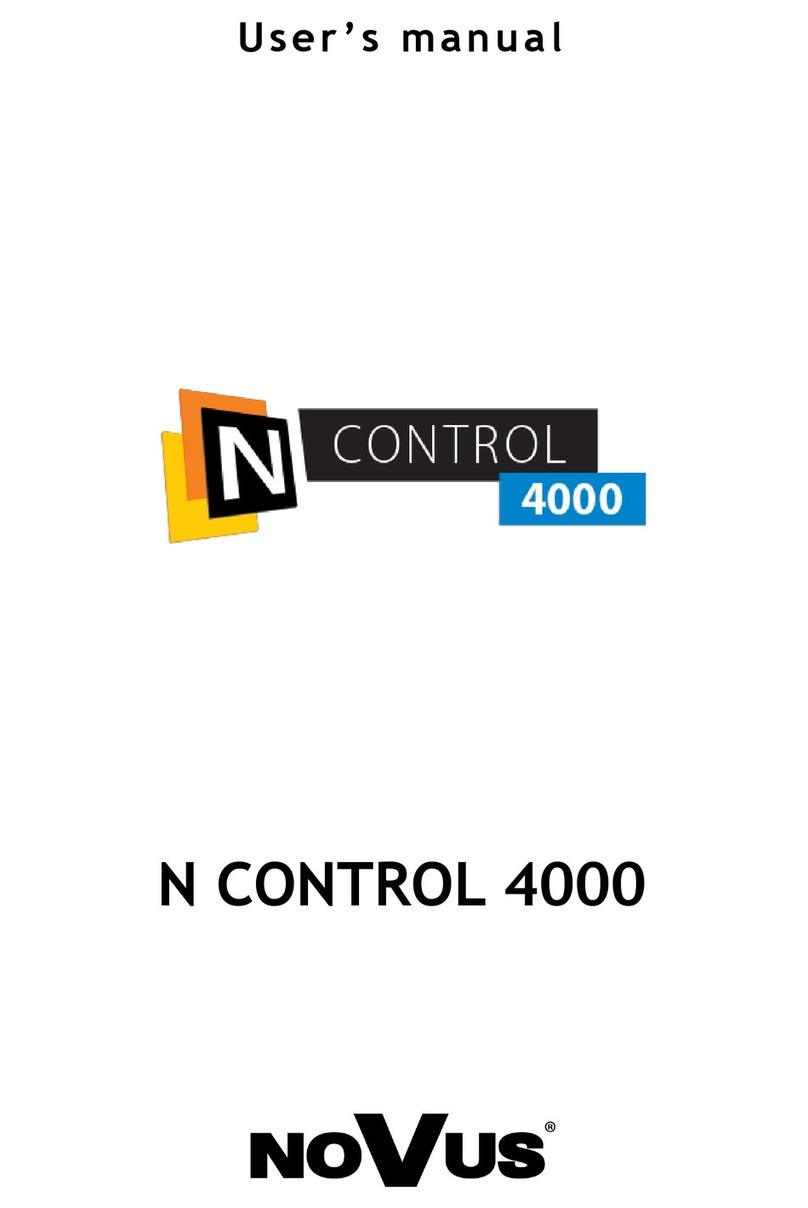
Novus
Novus N CONTROL 4000 user manual
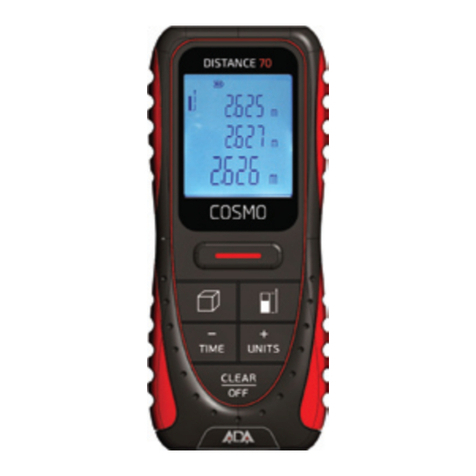
ADA INSTRUMENTS
ADA INSTRUMENTS COSMO 70eter operating manual
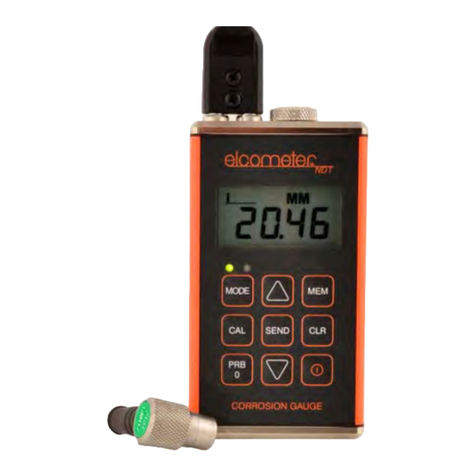
Elcometer
Elcometer CG30 operating instructions

P3 International
P3 International P0320 Specifications
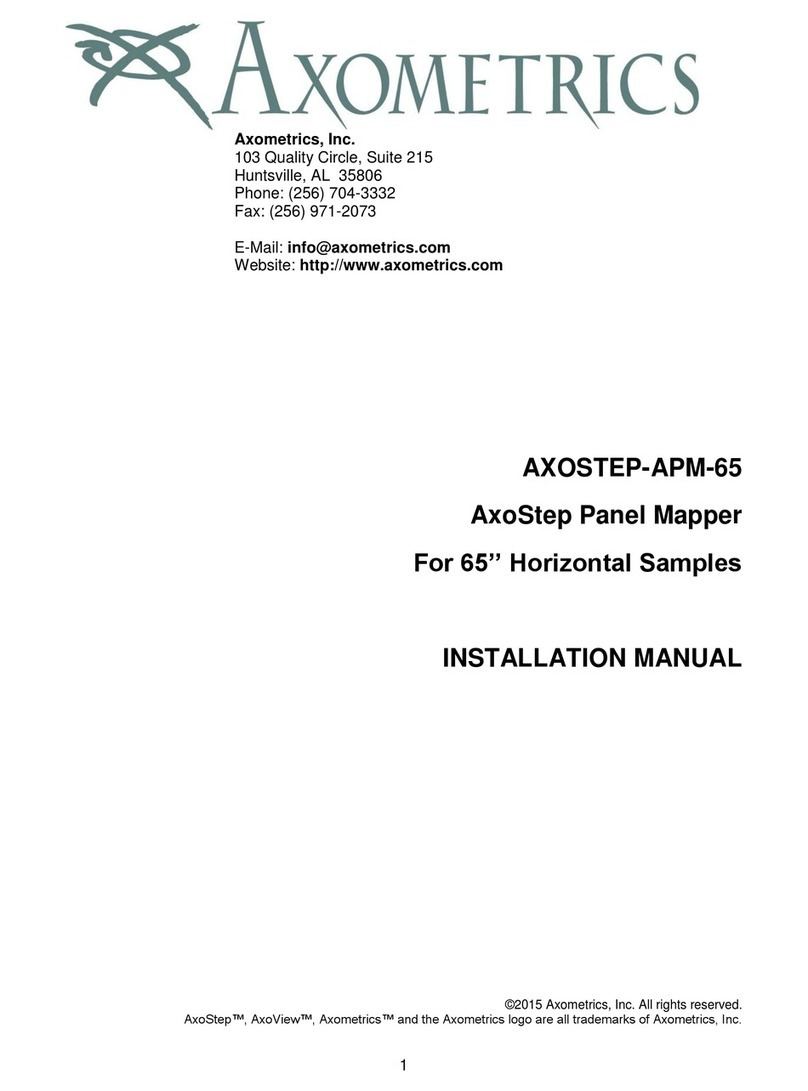
Axometrics
Axometrics AXOSTEP-APM-65 installation manual

Tektronix
Tektronix MTS4000 MPEG Quick start user manual
